Books: english
Books: english
![Cover of OEI #94-95 Geografier [Geographies]](https://rile.space/storage/1488/0216_Scan2022-04-15_140650_004.jpg)
OEI #94-95 Geografier [Geographies]
Jonas J. Magnusson, Cecilia Grönberg and 1 more
The new publication triangulates between geopoetics, geopolitics, and cultural geography; a 464 page issue with some 50 contributors as well as a large section on Swedish philosophical geographer Gunnar Olsson.
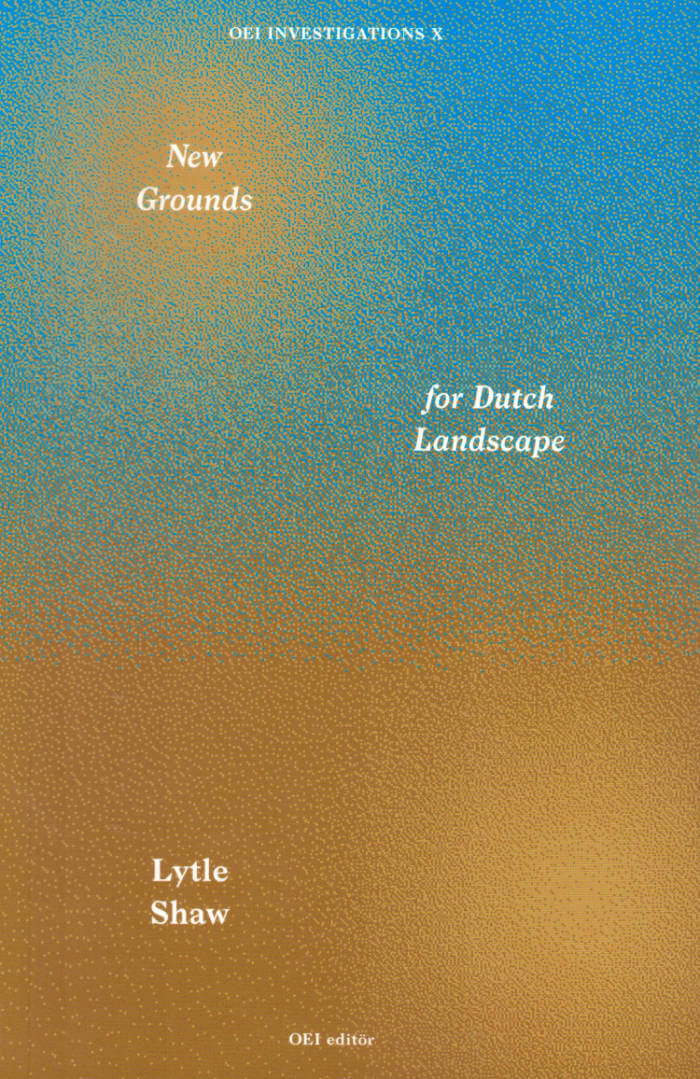
New Grounds for Dutch Landscape
New Grounds for Dutch Landscape uses an experimental, site-specific method to demonstrate how 17th century painters Jan van Goyen, Jacob van Ruisdael, and Meindert Hobbema did not so much represent the newly made landscape of Holland as reenact, through their painterly factures, its reclamation and ongoing threats to its stability: from flooding and drainage to abrasion and erosion.
These low-level dramas of recalcitrant matter allowed the Dutch to develop an ongoing temporality at odds with history painting’s decisive instant and a vocabulary of substance that wrested meaning away from humanist landscape painting’s expressive figures. — [publisher's note]
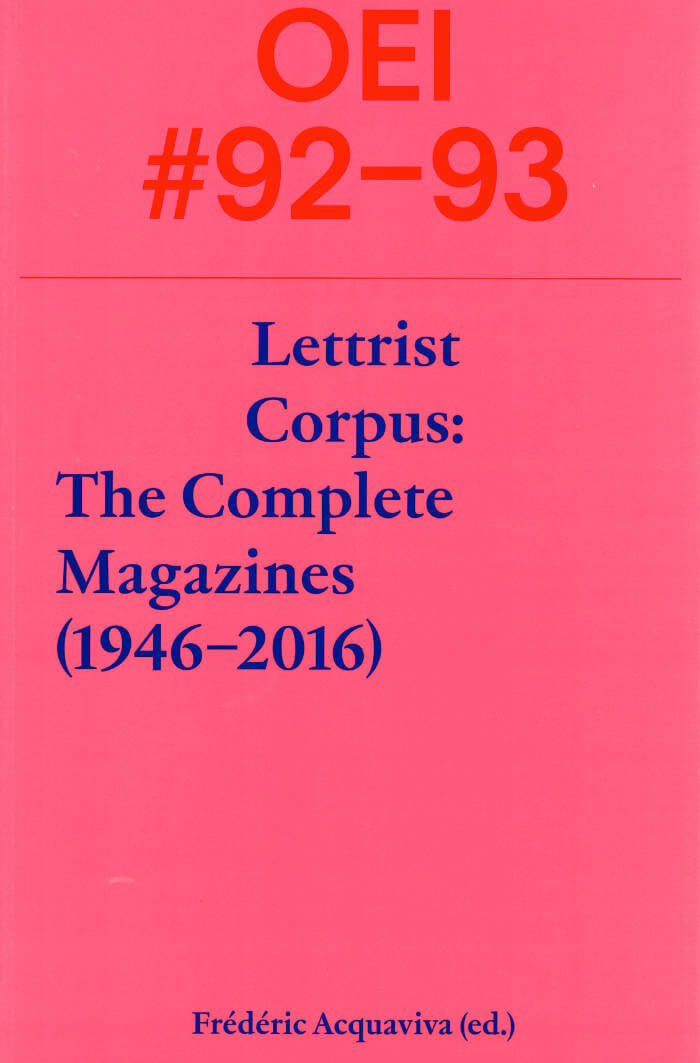
OEI #92-93 Lettrist Corpus: The Complete Magazines (1946–2016)
Frédéric Acquaviva, Jonas J. Magnusson and 1 more
“Un livre qui fera date. Deux ans de recherches, 512 pages, 1.361 illustrations en quadrichromie, 119 revues lettristes parues de 1946 à 2016 pour un total de 1.200 ouvrages décrits (avec la couverture et le sommaire de chaque numéro). Qui d’autre que les éditeurs suédois de OEI (Jonas J. Magnusson et Cecilia Gronberg) aurait pu sortir ce travail anthologique? Personne!” — www.mauricelemaitre.org
“The ‘unreasonable’ idea for this ‘catalogue raisonné’ came to me as an attemps to draw up a complete inventory of all the journals and periodicals of the Lettrist group, from its birth until today. Because the lifespan of the Lettrist movement has exceeded that of all the other avant-garde movements, we are undoubtedly in front of the most immense corpus ever produced in terms of magazines, coverin a period from 1946 to 2016. It presents more than a hundred different titles with more than one thousand items and hundreds of authors. . . . I hope that this comprehensive work will give the reader an opportunity to understand the different paths of the Lettrist groups and the many areas addressed, if not shaken, beyond the books of Isidore Isou and Maurice Lemaître. Since other Lettrists have published relatively few monographic books, and very little outside their own magazines, OEI #92-93 is a unique database for most of the Lettrist texts that we can access, also making it possible for new readers to come across Lettrism.”
— from Frédéric Acquaviva’s introduction
Design by Fält
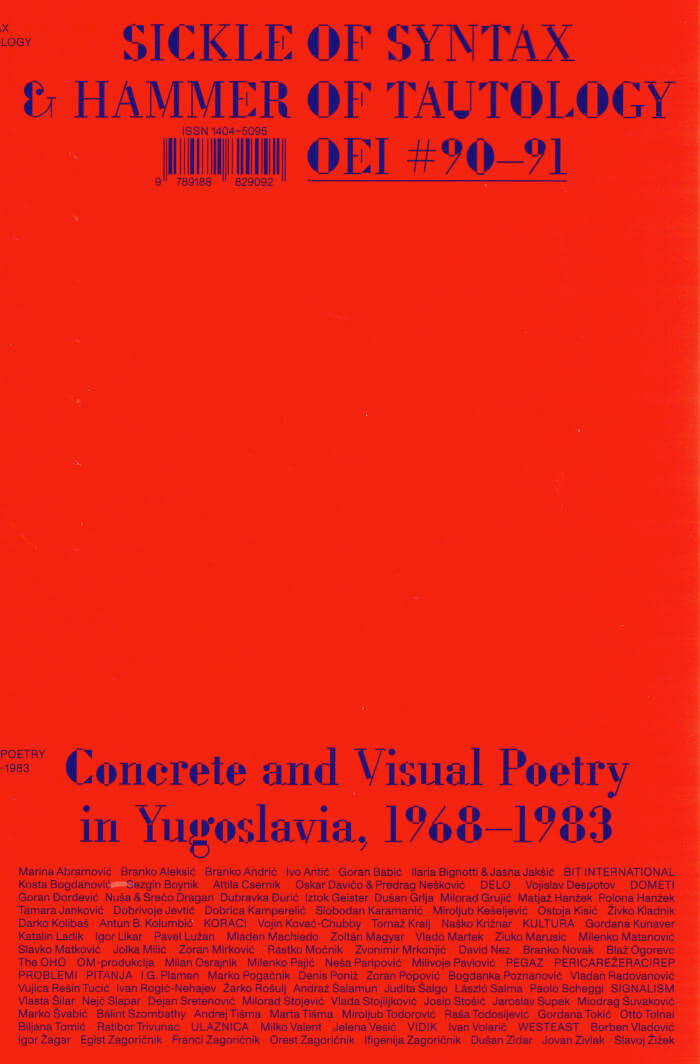
OEI #90/91 Sickle of Syntax & Hammer of Tautology
Tobi Maier, Cecilia Grönberg and 1 more
OEI # 90-91: Sickle of Syntax & Hammer of Tautology offers the first English language overview of the history of concrete and visual poetry production in socialist Yugoslavia between 1968 and 1983.
By focusing on mass-produced examples of concrete poetry, this publication presents these poetic experiments as organically linked to social movements, critical theories, and youth cultural revolutions. In his extensive introduction, Sezgin Boynik, the guest editor of this special issue of OEI, discusses concrete and visual poetry in socialist Yugo-slavia as an uneven and combined development, and emphasizes its confrontational and organizational aspects.
By means of interviews, translations, reproductions, and theoretical and historical statements, OEI # 90-91 offers a picture of a very lively scene of concrete and visual poetry in Yugoslavia, which unfortunately is not as recognized interna-tionally as it would deserve.
Hoping that OEI # 90-91 could contribute to this task in a substantial way, we present episodes from the early years of OHO formation and its complex theories of words and things; an interview with Rastko Močnik on programmed art and political formalism; militant polemics of Goran Babić; Signalist contradictions; subjective structural devices of Judita Šalgo; zaum experiments of Vojislav Despotov; detective meta-texts of Slavoj Žižek; poetic self-management studies of Vujica Rešin Tucić; a feminist historicisation of Ažin school for experimental poetry; democratisation of visual poetry by Westeast; selections from special issues of the journals Pitanja, Problemi, Ulaznica, Dometi, Delo, Koraci, Vidik, Pegaz, and many other materials translated here for the first time and presented in one publication.
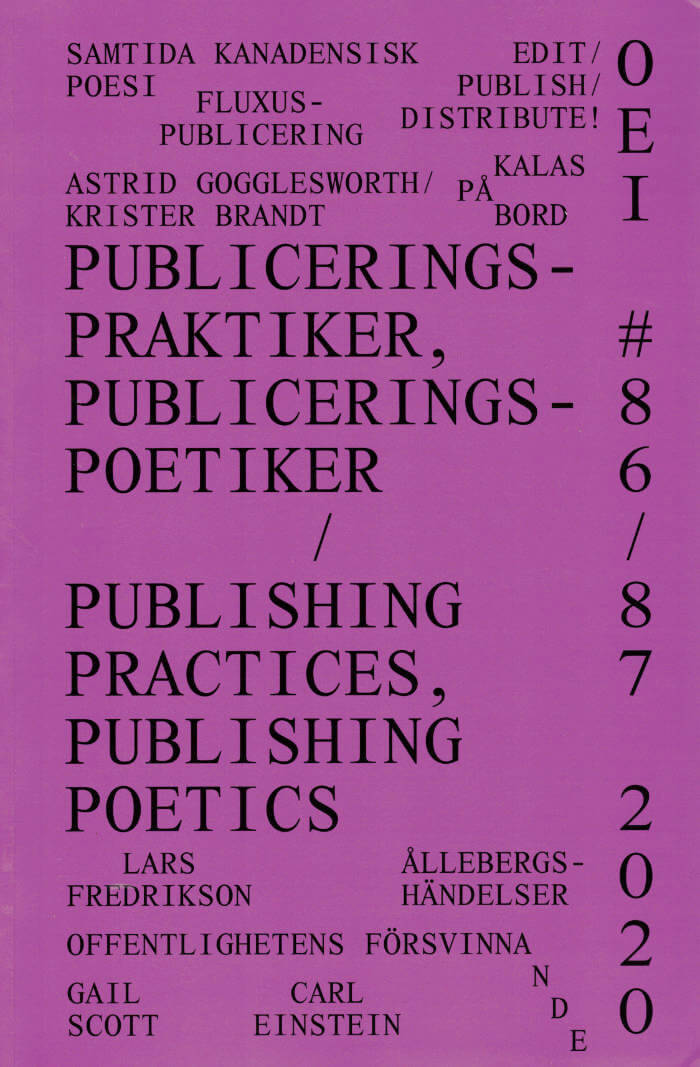
OEI #86/87 Publishing Practices, Publishing Poetics
Tobi Maier, Cecilia Grönberg and 1 more
Once more, an astonishing issue of OEI – a thrilling, compelling, stimulating feast of ideas regarding publishing and the book: the perfect big companion to read and hug in bed while the virus spreads outside.
Bringing together contributions from circa 130 publishing structures, publishing communities, magazines, small press endeavors, artists, poets, writers, editors, theoreticians, curators, scholars, and art bookstores, OEI # 86–87 reflects upon the challenges, pressures and possibilities of publishing and creating publics in different contexts and places in a time of far-reaching – economical, medial, political, social, technological – transformations.
The potential and the versatility of publishing open it to a diversity of practices and approaches in the arts, but as an eminently social form of art, a collective or micro-collective work with shared responsibilities, it is also a never-ending process of “crafting a variegated approach to how you create, publish, distribute, and build a social ecosystem around your efforts”, of trying to “build up and strengthen the community around these printed forms” (Temporary Services).
It is the conviction of OEI #86–87 that print has the power to play an important part in the construction of social spaces, of a social world. As Benjamin Thorel puts it in one of the essays in the issue, “conceiving of the dynamics of publishing as making publics as well as making things public is not a pun – insofar as the artists/publishers encompass, beyond the book itself, its possible ‘lives’, imagining the different spaces, and the different people, amongst whom a publication will circulate.” This is what Michael Warner has called “a public [as] poetic worldmaking”, implying “that all discourse or performance addressed to a public must characterize the world in which it attempts to circulate, projecting for that world a concrete and livable shape, and attempting to realize that world through address.”
This is also, as stressed by Annette Gilbert and others, what can make publishing such an active force, a force co-constituting texts and publications and publics. Indeed, with Michalis Pichler, it is tempting to say that in publishing as practice – perhaps more than in any other art field – “artists have been able to assert the aesthetic value of their own socio-politically informed concerns and to engage, often under precarious conditions, in cultural activities fully aligned with their political values.”
OEI #86–87 also includes sections on and with contemporary poetry from Canada; Fluxus publishing; Krister Brandt/Astrid Gogglesworth; Kalas på BORD (Öyvind Fahlström); Lars Fredrikson; Claude Royet-Journoud’s poetry magazines; Carl Einstein; Gail Scott; Ållebergshändelser; OEI #79: edit/publish/distribute!; “det offentligas försvinnande” and many many other things. [publisher’s note]
Design by Konst & Teknik

OEI #82-83 Art in the Age of Kleptomania
Jonas J. Magnusson, Cecilia Grönberg and 1 more
Aeron Bergman and Alejandra Salinas, co-editors at INCA Press (along with Irena Borić), are the guest-editors of this issue of OEI: it contains essays, artworks, and archival materials by 21 artists, theorists, writers, and artist-run spaces (mostly from the Americas).
The subject of the issue is art and neoliberalism, and it encompasses essays, images and other works by Dorothée Dupuis, Max Jorge Hindered Cruz, Luciano Concheiro, Yvonne Osei, Diego Bruno, John Riepenhoff, Suhail Malik, Good Weather, The Luminary, Bikini Wax, Beta-Local and more.

OEI #80/81 The Zero Alternative
Tobi Maier, Cecilia Grönberg and 1 more
OEI #80-81 is not an anthological publication, and has no representative ambition. It is a montage-based publication trying, in as material a way as possible, to register, prolong, transform and reflect upon energies from the work of Portuguese artist Ernesto de Sousa and his fellows (Alberto Carneiro, Túlia Saldanha, Álvaro Lapa, Fernando Calhau, Lourdes Castro, Ana Vieira, Ana Hatherly, E.M. de Melo e Castro, António Barros...).
Ernesto de Sousa and his fellows defined themselves as aesthetic operators and worked as filmmakers, photographers, curators, critics, writers, folk art researchers, multimedia artists... OEI #80-81 also gathers texts on magazines such as Poesia Experimental, Operação, Nova, A Urtiga, and Alternativa; and works by artists from younger generations such as Isabel Carvalho, Paulo Mendes and Mariana Silva, in dialogue with that of de Sousa.
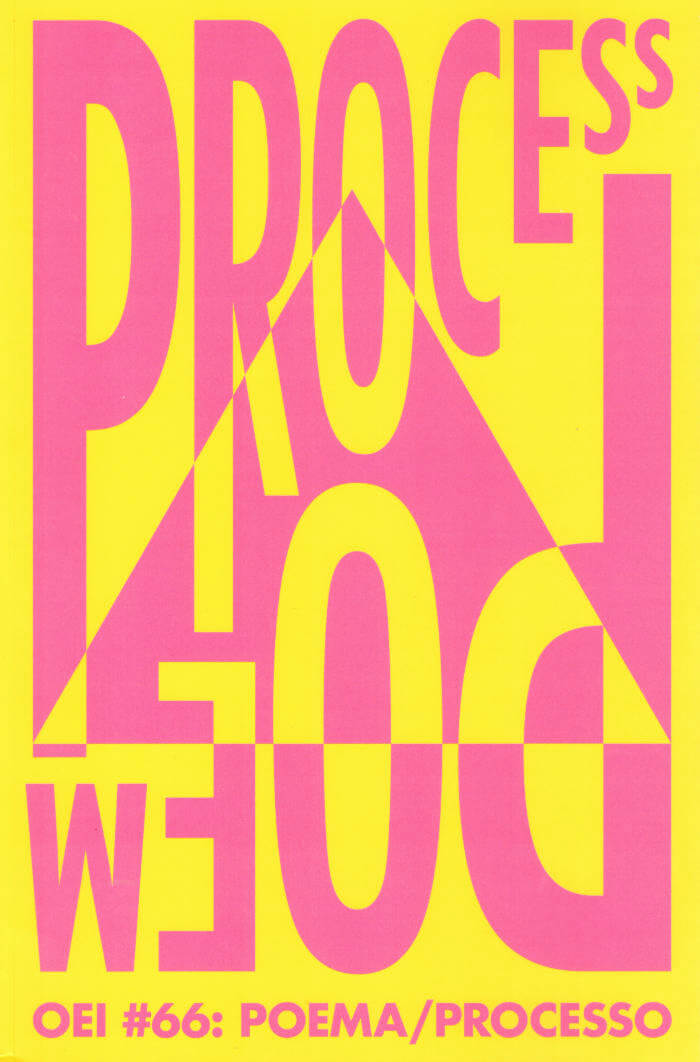
OEI #66 Poema/Processo (Process/Poem)
Jonas J. Magnusson, Cecilia Grönberg and 1 more
“We were not claiming European influences, as concrete poetry did. Europe would not accept a visual culture born in Brazil, so this claiming was necessary for concrete poetry, but not for poema/processo as it had pan-Latin-American connections” (Wlademir Dias-Pino)
Already a classic, this issue of OEI presents the Brazilian avant-garde movement Poema/Processo through a huge selection of images, poems, and short essays, showing the different strategies this movement used between 1967 an 1972 in order to survive and develop under the pressure of the militarian regime. Are also featured three other less-known Brazilian movements from the 60s, 70s and early 80s: poesia práxis, poesia marginal, pornismo.
With Wlademir Dias-Pino, Wlademir Dias-Pino, Moacy Cirne, Álvaro de Sá, Fernanda Nogueira, Priscilla Guimarães Martins, João Felício dos Santos, Rogerio Camara, Neide de Sá, Eduardo Kac, Antonio Sergio Bessa, Décio Pignatari, Luis Ângelo Pinto, Décio Pignatari, Dailor Varela, Falves Silva, Jota Medeiros, Cristina Freire, Dácio Galvão, Clemente Padín, Almandrade, Mário Chamie, Sergio Cohn, Omar Khouri, Régis Bonvicino, Regina Silveira, Hudinilson Jr.
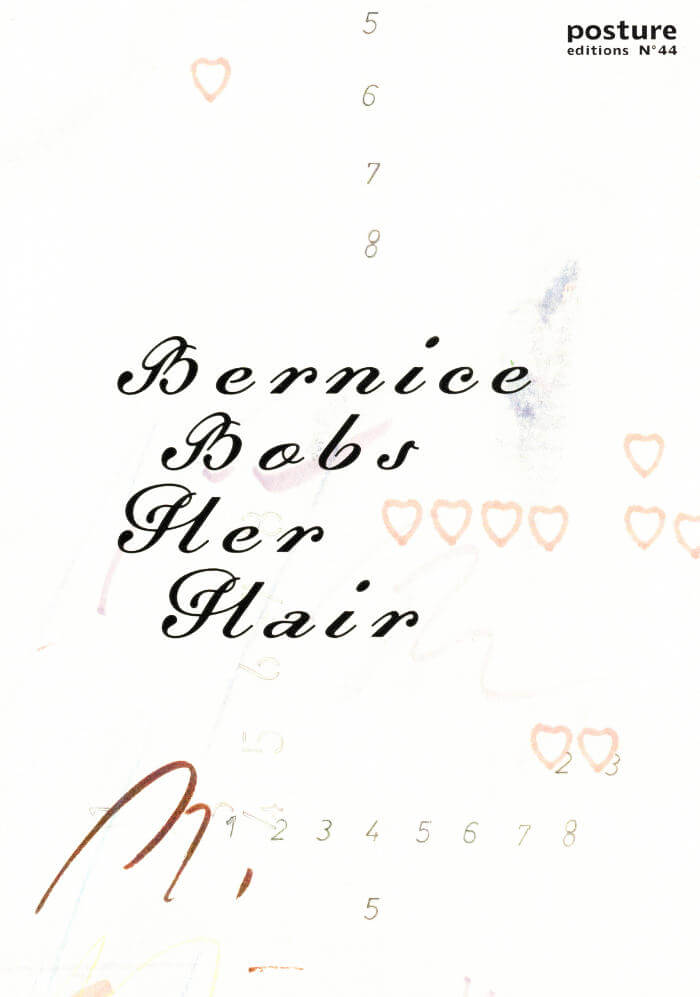
Bernice Bobs Her Hair
‘Bernice Bobs Her Hair’ is a series of layered soft ground etchings, drawings and monotypes. The title is a nod towards a Fitzgerald story about Bernice, who changes her approach to traditional gender roles and youth over a visit to her niece Marjorie. The act of having her hair cut transforms her character into a real flapper and brings her to a new perception of femininity.
Starting from the biased idea and normative use of marginalised graphic procedures as a means of reproduction, the idea of repetition is explored so that iterations become alterations or modifications of the same.
Simultaneously, associations cease to exist and the pregnant B, punning at times, as form and counterform encloses the work.
Fluid figures, painterly gestures and cartoonish scrawls and patterns are subject to a reflection on cuteness, power (-lessness), sexuality and domesticity.
By highlighting marginalised modes of artistic practice and craft-informed techniques, Mabesoone recoups visual languages that have habitually been coded as ultra-feminine and trivial. She questions how these ambiguous and subversive aesthetics can gain authority, and destabilise or resist contemporary realities and dominant cultural constructions.
The book contains poems by Veva Leye and a republication of ‘Trimmings’ by Harryette Mullen.

Rainbow Woman
In her work, Dutch artist Femmy Otten (°1981) explores a very hybrid world of inspiration, ranging from sculptures from Greek antiquity and Italian painters of the quattrocento to American outsider art and contemporary art. She brings all these influences together in a precise yet unfathomable iconography.
The book Rainbow Woman shows mainly recent work, but also revisits a number of older works which Otten has regularly placed in a new context throughout her artistic practice and which have now also been given a new shape in the context of the exhibition in the Warande, Turnhout (01.08-07.11.2021).
Rainbow Woman shows Otten as a versatile painter, sculptor, draughtsman and performer. In ‘Donna Universale’, the art historian Leen Huet places Otten in a tradition of self-confident, female artists that Europe has known since the early Renaissance but who have only sporadically entered the history books as artistically accomplished artists.
The book has many points of contact with the exhibition Rainbow Woman but can also be seen as a sequel to the artist’s book Slow Down Love (2016, nai).

Horaizon
Meggy Rustamova’s (b. 1985) practice explores films and spatial installations, in which she incorporates photographs, essays and audio material; often the work has a performative character. Concerned with the relations between individual and collective memory, language and human behaviour, her works look for ways to translate the current matters and phenomena in the world.
The title of the book and the exhibition, HORAIZON, refers to the phonetic pronunciation of the English word ‘horizon’, the boundary line on which the earth’s surface and the sky seem to touch. The horizon, interpreted as ‘boundary’ or ‘line’, is equally perceptible in language, when reading between the lines, or when travelling between international borders. The contours of the land, trees or buildings, which contrast with the sky, but also the contours of shadows can be observed in many of the images in the exhibition. The works also suggest a longing for what lies behind the horizon and invite the viewer to make an imaginary journey.
On the occasion of Rustamova’s exhibition at the Vrienden v/h S.M.A.K. and the book ‘Horaizon’, the artist created a multiple. The multiple is entitled 1000 km in Vogelvlucht — 621.371 miles at Bird’s Eye View and unfolds as a storyboard, with a collection of sky views and birds the artist has captured over the past two years. From a condor in Arizona to the black-backed gulls in Iceland in the North Atlantic Ocean all through the Sea of Marmara, the book seeks to create a tale that reflects on a person’s daily need for freedom, travel and nature.
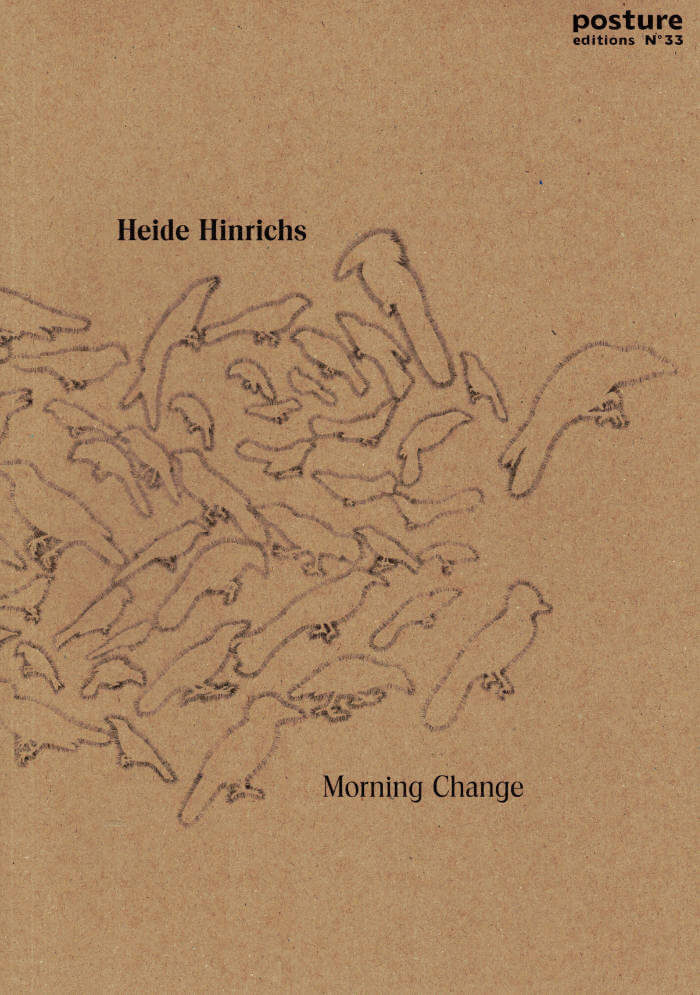
Morning Change
Morning Change is a book on movement, location and nomadism in the oeuvre of the Brussels based German artist Heide Hinrichs (b. 1976). It is an invitation to follow different lines that are directed east — east of Kassel, east of Busan, east of Seattle, east of London. The lines are drawn over continents and oceans, against the Earth’s own movement we unconsciously witness with each sunrise. Within the traces of these lines, static objects are put back into motion and they are made to leave their recommended positions of meaning.
The publication brings together three groups of works, developed over different periods of time between 1999 and 2018, exploring the artist’s recurring interest in these topics.
the horse — a story that starts 10 year after the fall of the Iron Curtain, Silent Sisters / Stille Schwestern together with a series of drawings and installations that were conceived in response to DICTEE — a text written by the Korean-American artist Theresa Hak Kyung Cha and On Some of the Birds of Nepal (Parting the Animal Kingdom of the East) — an installation that Hinrichs created in the context of the first Kathmandu Triennale 2017.
An essay by Elizabeth Haines is woven through Morning Change.

Hundred Zundert
Nel Aerts (b. 1987) moves in a freely, intuitive way between different media as painting, drawing, collage, performance and sculpture. Since a few years she focuses more often on the portrait-genre, which she visualises on paper or on wooden panels, with careful attention to the different qualities of each material. As such, she is creating a large collection (family almost) of posing subjects caught between abstract patterns and hard-edged figuration. The figures she portraits refer to both popular culture and her direct, everyday surroundings.
The self-portraits are tragicomic in the sense of the contrasts they evoke. Alternately they are desperate or funny, extra- or introverted, thought- or playful carved from wood or originated as a collage, but they are always introspective and self-relativistic.
In Hundred Zundert, “Nel Aerts evokes a visual rendezvous with Vincent van Gogh and sets the tone for the near one hundred drawings that would be made during her three-month residency at the Van Gogh House in Zundert. Rather than ‘following in the footsteps of Van Gogh’, Aerts is interested in examining the mud and earth around them by (literally) placing herself in the environment of Van Gogh’s youth. The resulting work is characterised by a deceptive interplay between formal simplicity and playfulness which belies a substantial complexity. (…) Nel Aerts’s working process is uncomplicated and free of any pretension: black ball pen (dozens), sheets of white A4 paper (hundreds) and spontaneous, almost naive line work (in seemingly infinite supply) are the building blocks of a story that is nevertheless rich in visual and intimate detail, a story that teeters between seriousness and playfulness, at once both comical and deeply emotive.” From: ‘Portrait of the Artist’, Grete Simkuté, in: Hundred Zundert.

Time and Tide
“In selecting the photographs for this publication, Lisa Spilliaert (b. 1990) was adamant that the image of a sunrise should be among the first in her book. It is, indeed, an emblematic image. For anyone with a camera, such a splendid sunrise is an irresistible trope: a visual motif that simply begs to be captured and fixed on film. In reality, however, the magic of this scene resides in the fleeting, subtle changes in colours and vibrations. This is the dynamic that captivates us.
Photography is usually understood as a technique for ‘stopping’ the flow of time. But as Spilliaert here demonstrates, the impact of photography can also be used to manifest an awareness of time and transience. By accentuating the photographer’s fixed position vis-à-vis the endlessly changing light source, Spilliaert evokes a correlation between stasis and movement, between the cosmic and the mundane. This duality is echoed again in the confrontation of the two equivalent silhouettes: that of the photographer and of his alias or ‘partner’: a life-size technical camera.” — From ‘Time and Tide’ Edwin Carels

Stili Drama XIII-XXI / La Giostra di Lulu XLI-XLIV
The materials collected in the publication have been developed departing from the documentation, transcription and translation of textual, visual, sculptural and audio materials produced between March and November 2021 for STILI DRAMA.
STILI DRAMA is an open-ended episodic para-cinematographic project, which functions as a spontaneous expression of MRZB research. STILI DRAMA XVIII-XXI and LA GIOSTRA DI LULU XLI-XLIV are the two first fragments of the work.
Language: English, Italian
Edition of 100 copies

Hatred of Sex
Hatred of Sex links Jacques Rancière's political philosophy of the constitutive disorder of democracy with Jean Laplanche's identification of a fundamental perturbation at the heart of human sexuality. Sex is hated as well as desired, Oliver Davis and Tim Dean contend, because sexual intensity impedes coherent selfhood and undermines identity, rendering us all a little more deplorable than we might wish. Davis and Dean explore the consequences of this conflicted dynamic across a range of fields and institutions, including queer studies, attachment theory, the #MeToo movement, and "traumatology," demonstrating how hatred of sex has been optimized and exploited by neoliberalism.
Advancing strong claims about sex, pleasure, power, intersectionality, therapy, and governance, Davis and Dean shed new light on enduring questions of equality at a historical moment when democracy appears ever more precarious.
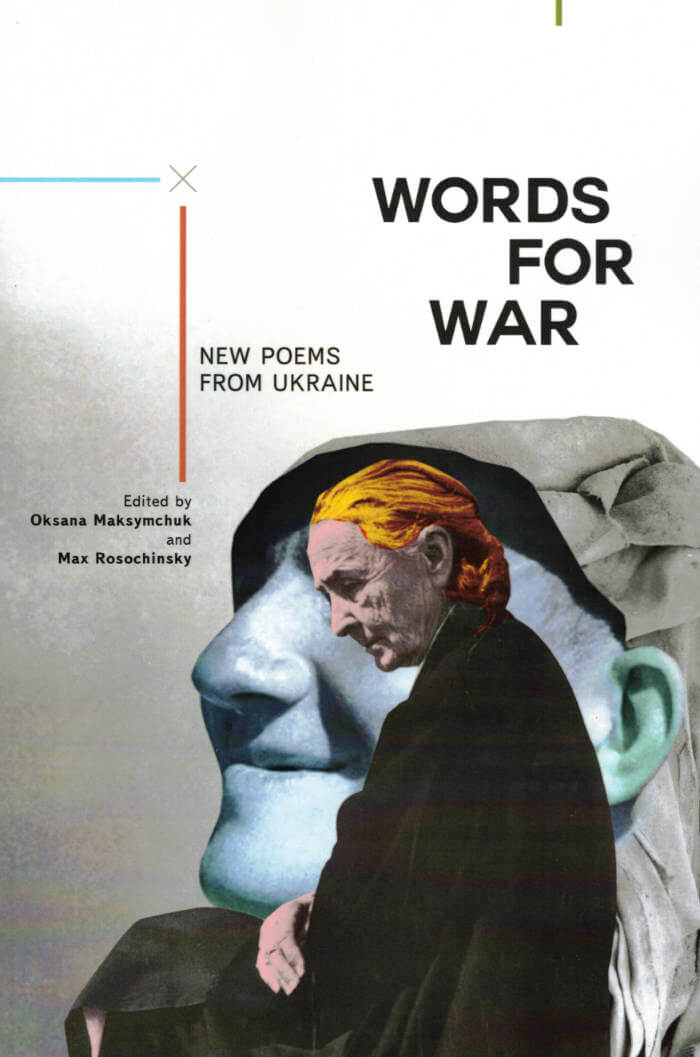
Words For War
The armed conflict in the east of Ukraine brought about an emergence of a distinctive trend in contemporary Ukrainian poetry: the poetry of war. Directly and indirectly, the poems collected in this volume engage with the events and experiences of war, reflecting on the themes of alienation, loss, dislocation, and disability; as well as justice, heroism, courage, resilience, generosity, and forgiveness. In addressing these themes, the poems also raise questions about art, politics, citizenship, and moral responsibility.
The anthology brings together some of the most compelling poetic voices from different regions of Ukraine. Young and old, female and male, somber and ironic, tragic and playful, filled with extraordinary terror and ordinary human delights, the voices recreate the human sounds of war in its tragic complexity.

Five Essays from Present Continuous
The five essays printed here are excerpted from Part I of Present Continuous, a book of prose written during the first year of the coronavirus pandemic between March 2020 and April 2021 in Lewisham, London.
The essays in the present volume were written between March 2020 and June 2020: the movement from spring to summer, from the first announcement of a national lockdown to the Black Lives Matter protests sparked by the murder of George Floyd and Breonna Taylor in the United States and the death of Belly Mujinga in the UK. Nearly two years on, following a seemingly endless series of virus variants and subvariants, an apparent shift from pandemic to endemic, and a kind of exhaustion of vocabulary and will, I hope they provide some sort of record, not just of where “we” were in 2020, but where “we” are – or might be – now. (David Grundy, London, January 2022)
“It’s 2018 and we’re still on a train out of London, it’s 1967 or 1970 and Coltrane and Ayler are still in their material form, it’s 1943 and Artaud’s letters spill their remainder on the page, it’s April 2020 and all those presences are gone but their traces remain in the split voice, the overtone, the greater frequency overwhelming that base note which no longer guides in circumscribed lines. The actual presence of actual ghosts, silver on the mirrors, lost poetry, the noise it makes. It’s from the condition of being in the abyss itself that we learn how to climb out of it.”

Acoustic Thought
Acoustic Thought is an exegesis of the Gospel of Thomas, an apocryphal gospel found at Nag Hammadi in Upper Egypt in 1945.
With a score for six female voices by Lisa Holmqvist; a collage of writings by medieval female mystics; and photographs taken by Jeff Weber at the Coptic Museum in Cairo, during a research period at Beirut project space.
The book’s covers reconstruct patterns found on the covers of Nag Hammadi Codex II, which, as well as the Gospel of Thomas, contains the Apocryphon of John, the Gospel of Philip, the Hypostasis of the Archons, On the Origin of the World, the Exegesis on the Soul, and the Book of Thomas the Contender.
Presented and performed during Perfomance Days, Amsterdam (November 2014) and Hotel Theory, REDCAT, Los Angeles (November 2015).
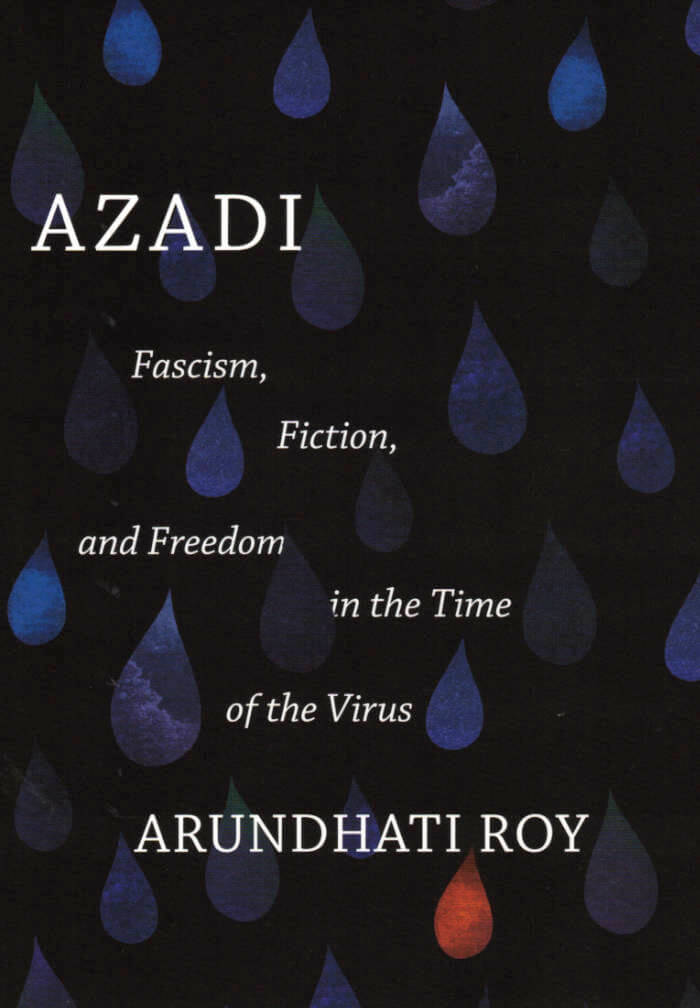
Azadi: Freedom. Fascism. Fiction.
The chant of 'Azadi!' — Urdu for 'Freedom!' — is the slogan of the freedom struggle in Kashmir against what Kashmiris see as the Indian Occupation. Ironically, it has also become the chant of millions on the streets of India against the project of Hindu nationalism. Just as Arundhati Roy began to ask what lay between these two calls for freedom — a chasm or a bridge? — the streets fell silent. Not only in India but all over the world.
The coronavirus brought with it another, more terrible understanding of azadi, making nonsense of international borders, incarcerating whole populations, and bringing the modern world to a halt like nothing else ever could.
In a series of essays, Arundhati Roy challenges us to reflect on the meaning of freedom in a world of growing authoritarianism
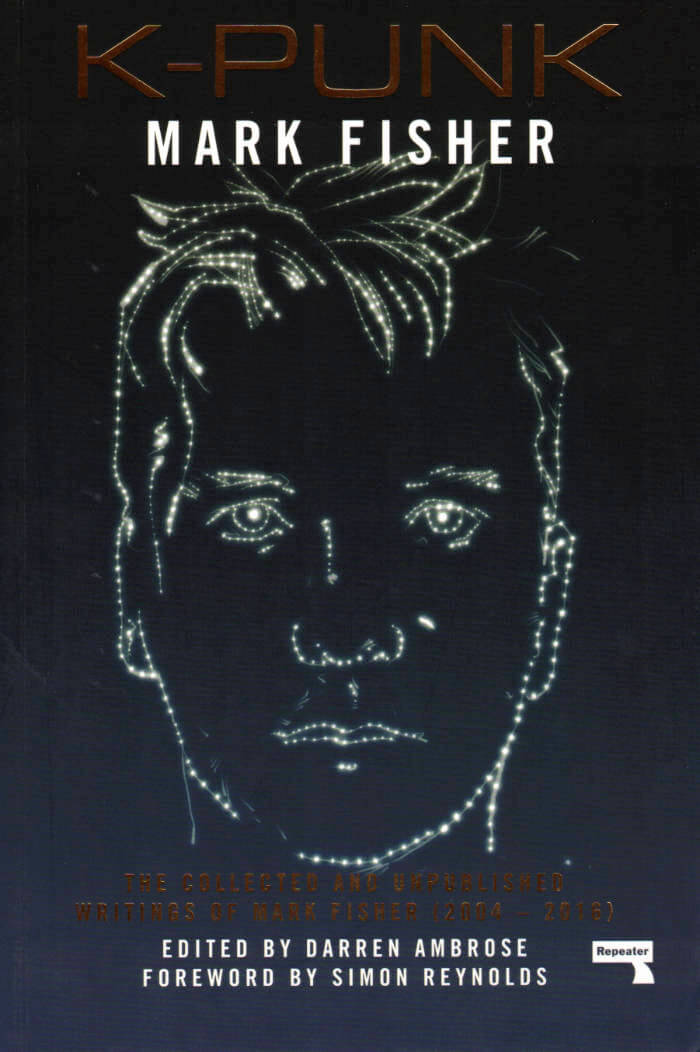
K-Punk: The Collected and Unpublished Writings of Mark Fisher
A comprehensive collection of the writings of Mark Fisher (1968-2017), whose work defined critical writing for a generation.
This collection brings together the work of acclaimed blogger, writer, political activist and lecturer Mark Fisher (aka k-punk). Covering the period 2004 - 2016, the collection will include some of the best writings from his seminal blog k-punk; a selection of his brilliantly insightful film, television and music reviews; his key writings on politics, activism, precarity, hauntology, mental health and popular modernism for numerous websites and magazines; his final unfinished introduction to his planned work on Acid Communism; and a number of important interviews from the last decade.
Edited by Darren Ambrose and with a foreword by Simon Reynolds.
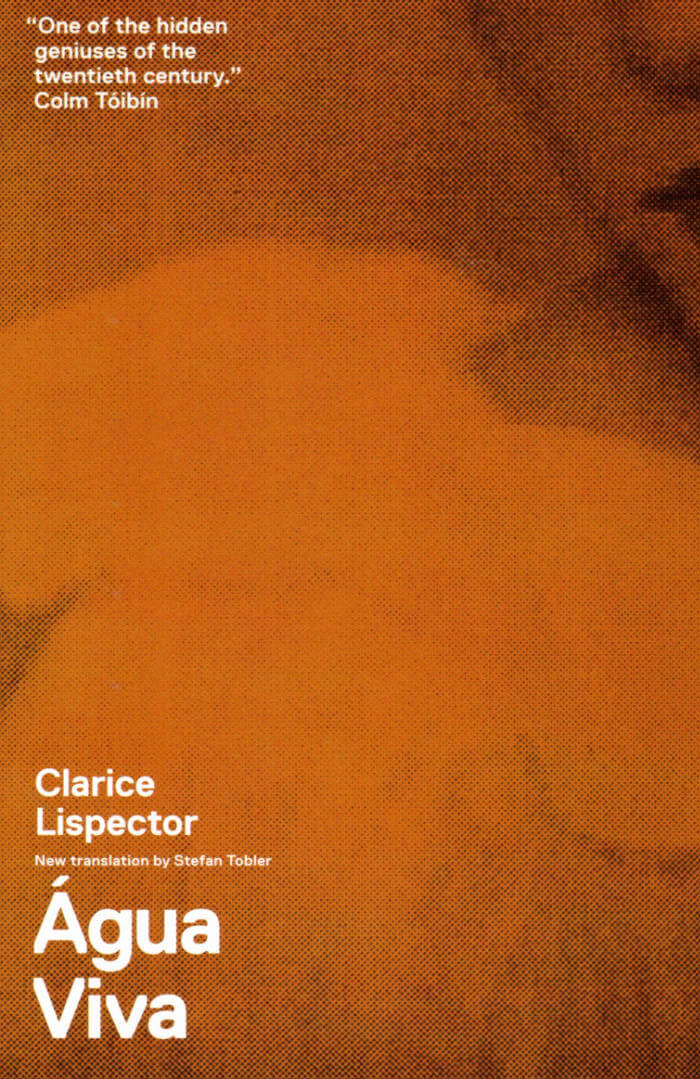
Água Viva
In Água Viva Clarice Lispector aims to 'capture the present'. Her direct, confessional and unfiltered meditations on everything from life and time to perfume and sleep are strange and hypnotic in their emotional power and have been a huge influence on many artists and writers, including one Brazilian musician who read it one hundred and eleven times. Despite its apparent spontaneity, this is a masterly work of art, which rearranges language and plays in the gaps between reality and fiction.
Clarice Lispector (December 10, 1920 – December 9, 1977) was a Brazilian writer acclaimed internationally for her innovative novels and short stories. Born to a Jewish family in Podolia in Western Ukraine, as an infant she moved to Brazil with her family, amidst the disasters engulfing her native land following the First World War.

Brown Rice
Don Cherry's ecstatic world fusion masterpiece of the '70s, wedding Indian, African, and Arabic music to Miles Davis' electrified jazz-rock innovations.
Brown Rice is probably the most accessible entry point into Cherry's borderless ideal, jelling into a personal, unique, and seamless vision that's at once primitive and futuristic in the best possible way. Its title track is a sensual fusion of various styles and sounds from the African, Indian and Arabic traditions. It also represents the spiritual multiculturalism that Cherry was interested in exploring during this creative period. With ex-Ornette Coleman cohorts on board—Billy Higgings on drums and Charlie Haden on double bass (also heard on electric)—the album (originally released in Italy in 1975) is a cult on its own.
Don Cherry (1936-1995), composer-trumpet player, flutist, percussionist and pianist, is an essential figure in American jazz, free jazz and avant-garde music.
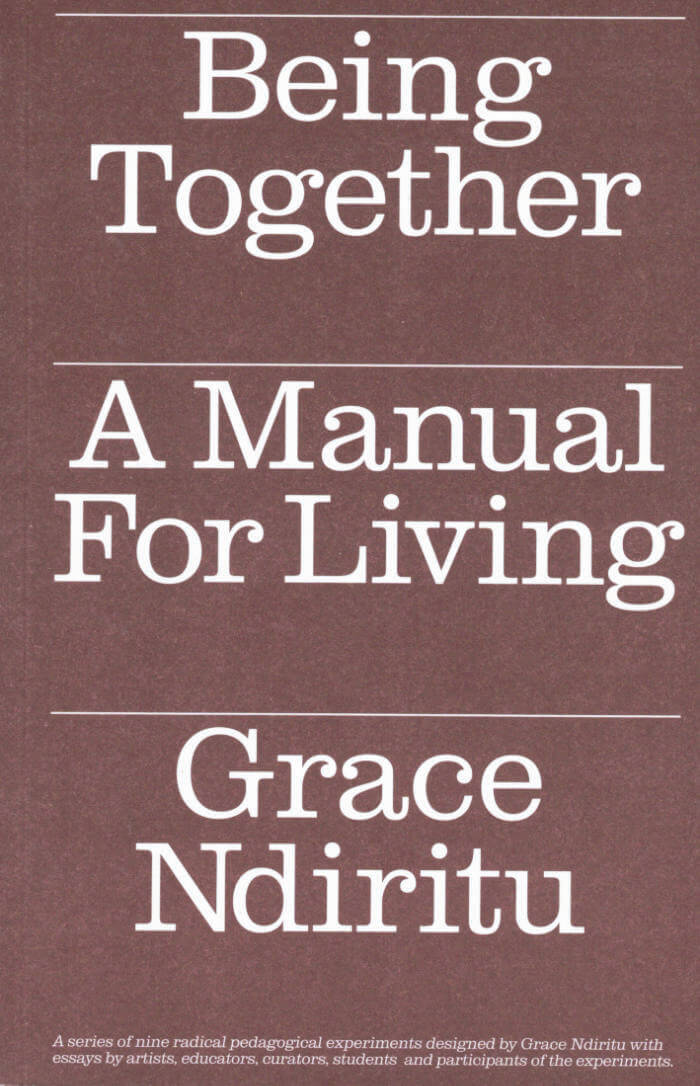
Being Together. A Manual for Living
Being Together: A Manual For Living falls in the lineage of publications such as The Journal of the Society for Education Through Art, which throughout the 1960s provided Britisch art schools a window into experimental education. By contrast, Grace Ndritu's experience in creating radical pedagogies arose from a connected, yet unorthodox system of 'self education'.
In 2012, she decided to spend time living in cities only when necessary. She thus lived in rural, alternative and often spiritual communities, while expanding her research into nomadic lifestyles, and training in esoteric studies, which she began following graduating art school. This research led her to visit Thai and Tibetan Buddhist monasteries, permaculture communities in New Zealand, forest tree dwellers in Argentina, neo-tribal festivals such as Burning Man in Nevada, a Scottish Hare Krishna ashram, and the Findhorn Spiritual Community in Scotland.
Such lifestyles forever transformed her ideas of education and have proven critical for her art, whether conducting social practices or working with students, peers and the general public; some of whose voices appear in this publication. Ndiritu posits, "What does (art) education mean today?" and specifically, "What does an embodied (art) education mean in a time of pandemics and social unrest?". Being Together: A Manual For Living attempts to answer these complex questions.
This book is published on the occasion of Grace Ndiritu's solo show at KRIEG? in Hasselt, Belgium.
Contributors: Philippe Van Cauteren, Pieter Vermeulen, Grace Ndiritu, Rafaela Lopez, Roberto dell’Orco, Jana Haeckel, Katleen Vermeir & Ronny Heiremans, Nathalie Boobis, Shayla Perreault, Edward Ball, Guadalupe Martinez, Stacy Suy, Ezra Fieremans.
Editors: Pieter Vermeulen, Grace Ndiritu
Copy editor: Sue Spaid
Design: Vrints-Kolsteren